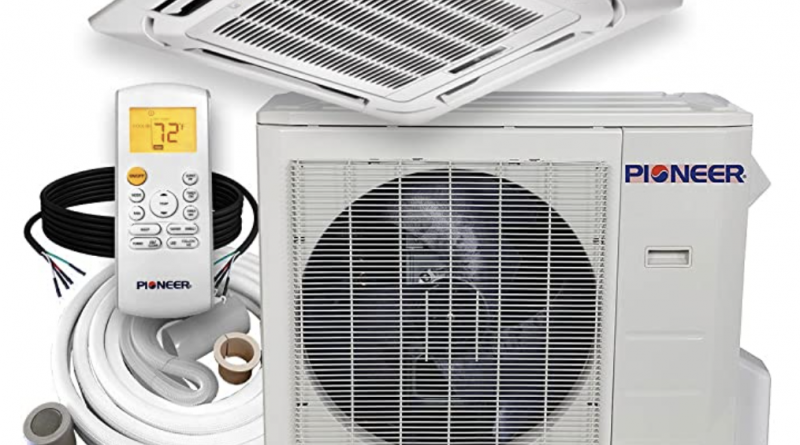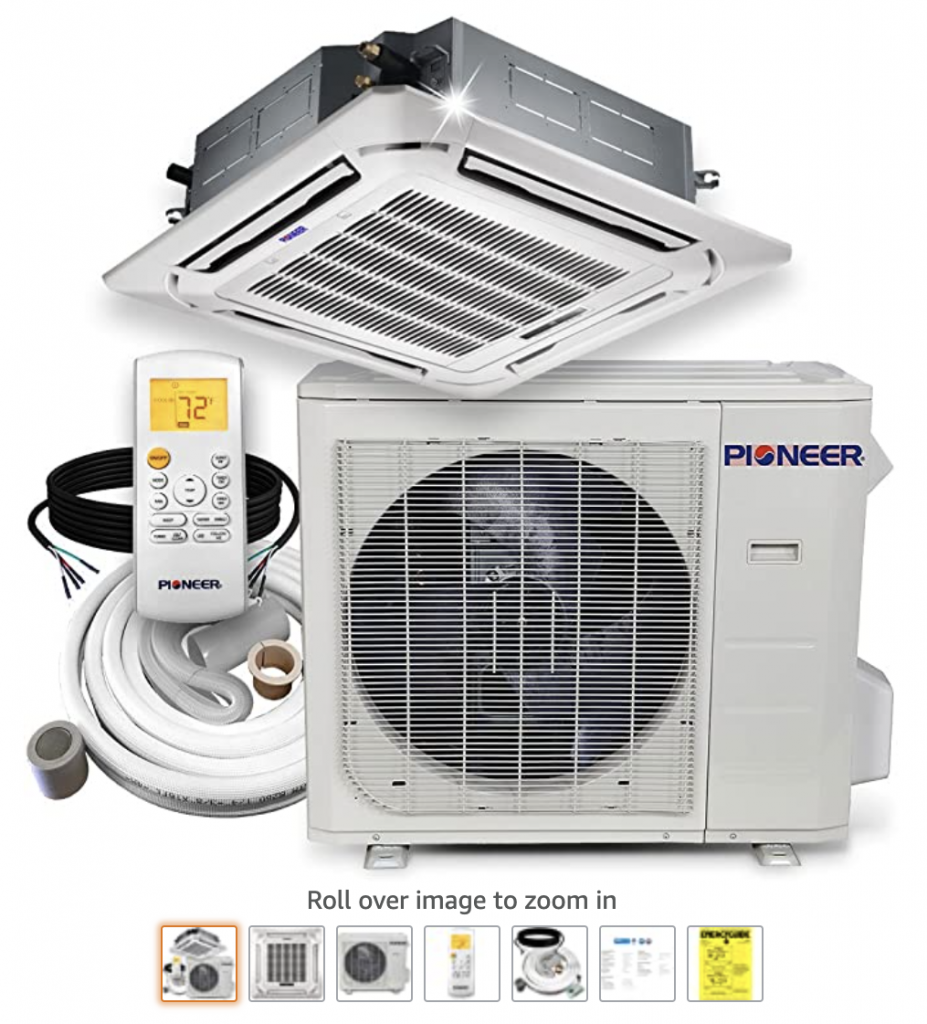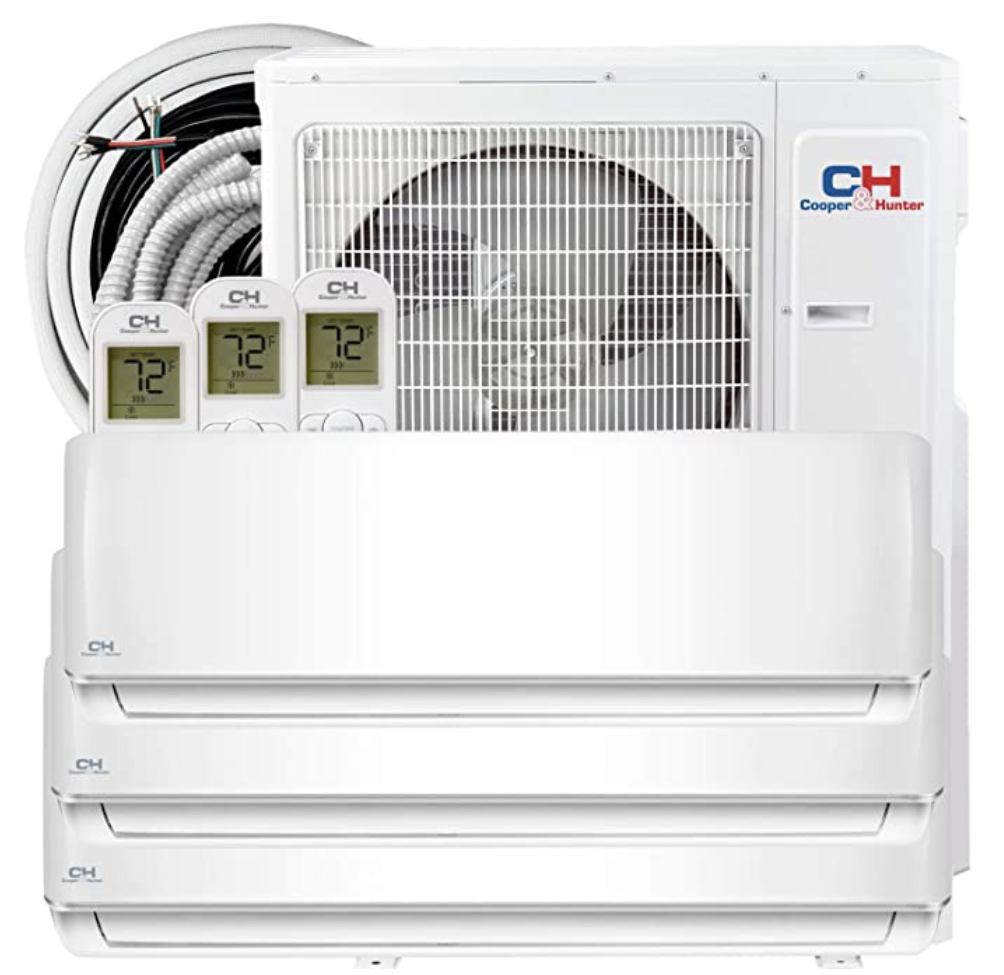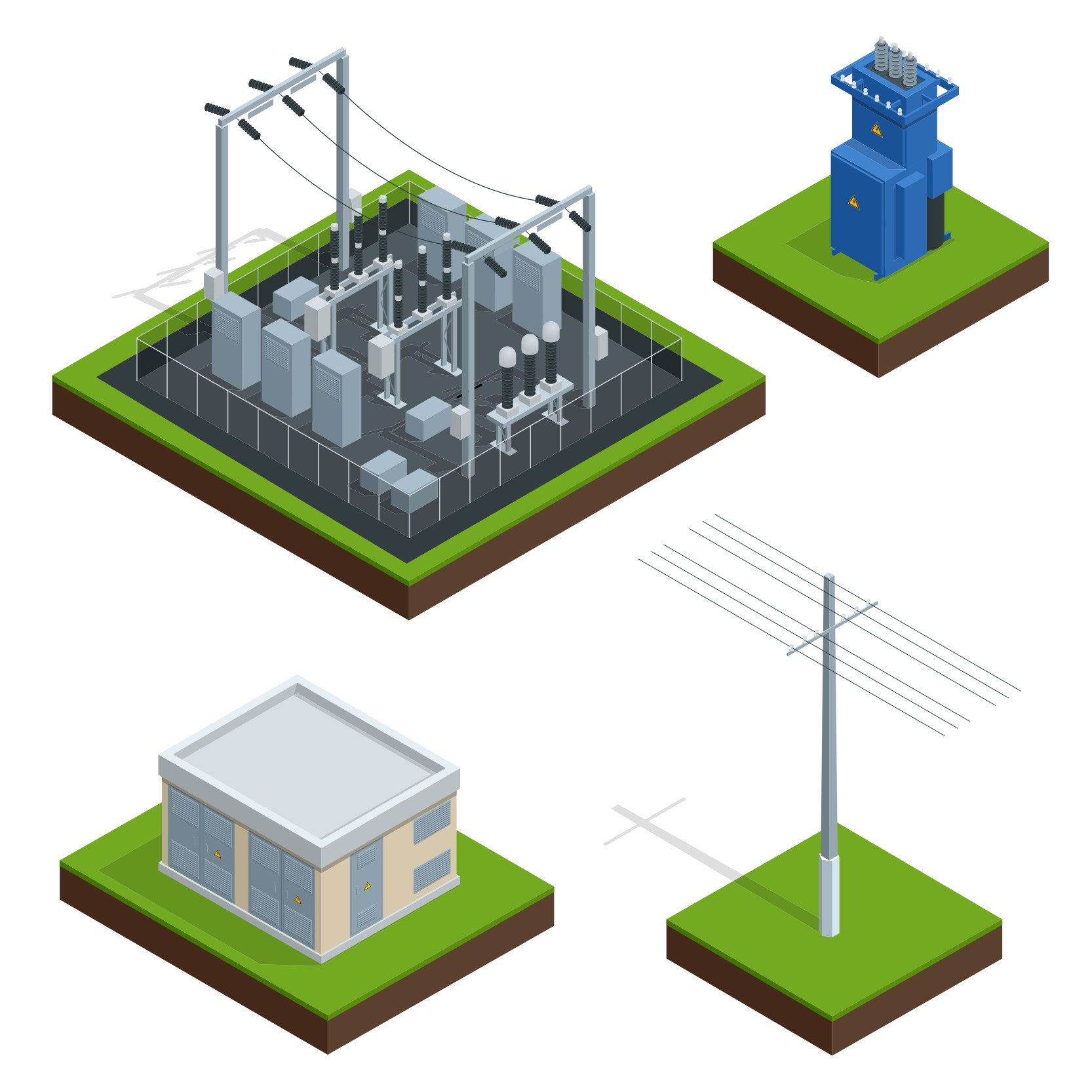Summer Breeze: Heat Pumps, Mini-Splits, and the Magic of Thermodynamics
I’m in the process of shopping for some air-source heat pumps for our 1895 Victorian house in Southwest Detroit. Heat pumps are basically like air conditioners, except they heat as well as cool. Presently, we have an aging steam boiler that’s probably about as old as I am. We do not have central air, but we have a lone air-source heat pump, a.k.a. mini-split, on the third floor. It’s a former attic space that is now a spacious master suite with a vaulted ceiling, a loft, a dormer, turret, bathroom, home office, and an extremely awkward, long, walk-in closet. As the boiler ages, it’s time to start thinking about electrifying the whole place. The problem is that in our world of unending consumer choice, it’s impossible to know how exactly we should be finding the best deals on things. I thus bring you: a simple comparison of BTU output per dollar!
I’m looking at a sample of n=17 units for sale from Amazon and n=33 from Alpine Home Air, both companies I’ve bought stuff from in the past.
Kill Bill: The Energy Savings Case
The big case for minisplits is the thermodynamic magic that occurs within that enables beaucoup savings. That’s right, folks! Upgrading from window air conditioners to minisplits could easily save you half or two thirds on your cooling costs. The calculation is via the Seasonal Energy Efficiency Ratio, or SEER. SEER is basically how much heat gets moved per watt input. A 12,000btu unit that uses 1,200 watts would be 10 SEER. 13-14 SEER is the minimum allowed by law in most of the US. In the example above, your current AC unit might run you $289 for 1.5 tons (18,000btus) at 9 SEER. Upgrading to 22 SEER would reduce your cost you around $118 per year, based on the above chart.
If you like our analysis, please consider becoming a supporter today for as little as $1 per month!
But it gets wilder still. Alpine Home Air is now selling a 38 SEER unit. This means that the three window units you currently have in your crib that use several hundred watts each to produce a measly 1.0 ton of cooling– will now use as little as 315 watts. I think my math is right there. Suffice it to say, this is several times more efficient than the window unit you got for free from your buddy when he was moving– which might not even crack a SEER of 10. Or 5. Who knows.
Ok, great– But What’s A Mini-Split?
Minisplits– typically “split system, air source, ductless heat pumps,” are so named because the system is “split” to do two separate functions of heating and cooling by way of reversing the thermodynamic sorcery within- have gained in popularity in recent years. It’s basically a very efficient air conditioner. But in the winter, it switches it up on you. Instead of extracting heat from the inside and blowing “cold” inside while blowing warm air outside, it’s doing the opposite– extracting heat from the cold, outdoor air, and blowing that heat inside. Normal electrical resistance heating allows us to convert one watt into a hair less than 3.41btus of heat. But refrigeration allows us to convert one watt into the equivalent of a few times that– more like 10-15btus. Freakin’ sorcery, right? Like I said.
They’re called “air source” because the medium through which the heat is being transferred is ambient air, either indoor or out. Contrast this to a ground-source heat pump, where a loop of some sort of thermal-conveying liquid is circulated through the ground and into the unit. A ductless system just means it blows air right into your room from the air handler, rather than through ducts like a furnace normally would.
These units usually have far more capability to modulate their heat or cooling output, meaning that system sizing is less critical. (For a regular furnace, an undersized system will run constantly. An oversized one will “short-cycle,” running for less time than it should, because it’s producing air that is too hot, and the air isn’t mixing properly). The effect is that instead of having the characteristic, metallic buzzing sound of a central air condenser in the summertime, a minisplit sounds more like a window fan on low speed.
The Efficiency Curve
Below is a chart extrapolating the efficiency curve from some data provided by Lennox, purveyors of air conditioners. A representative from Alpine told us that one SEER point works out to usually around a 7% efficiency gain. This appears to be roughly true within our curve– a hair above 6% per SEER point- until you get to around 25. We did the extrapolation because most public calculators don’t go above 25 SEER. Indeed, very few manufacturers make units with higher SEER numbers. (Movie trailer voice: until now!)

Why electrification?
Electrifying residential systems brings numerous benefits. At the macro level, you’re reducing the need for natural gas transmission infrastructure, which, along with natural gas extraction, contributes to a large portion of poorly-accounted GHG emissions. At the household level, you’re improving indoor air quality by a significant margin. Cooking with gas creates a lot of noxious molecular guests to your household air. Electrifying instead means you’re not creating carbon dioxide or other pollutants locally.
Finally, there’s no risk of carbon monoxide poisoning, nor of burning your house down with errant flue gas, because there is no combustion going on. This is going to become a more significant thing as prices for fuel increase, which they do, without fail, every year. As inflation becomes a bigger concern, utilities are also assuming massive costs in modernizing a deteriorating power grid. This is expensive, but it’s better for us to focus on electricity and the infrastructure for electricity than things like, you know, LPG distribution for trucks (glaring at Michigan).
Oh, and solar! But a few solar panels can power a high-efficiency mini-split. Solar panels can’t power a gas furnace.
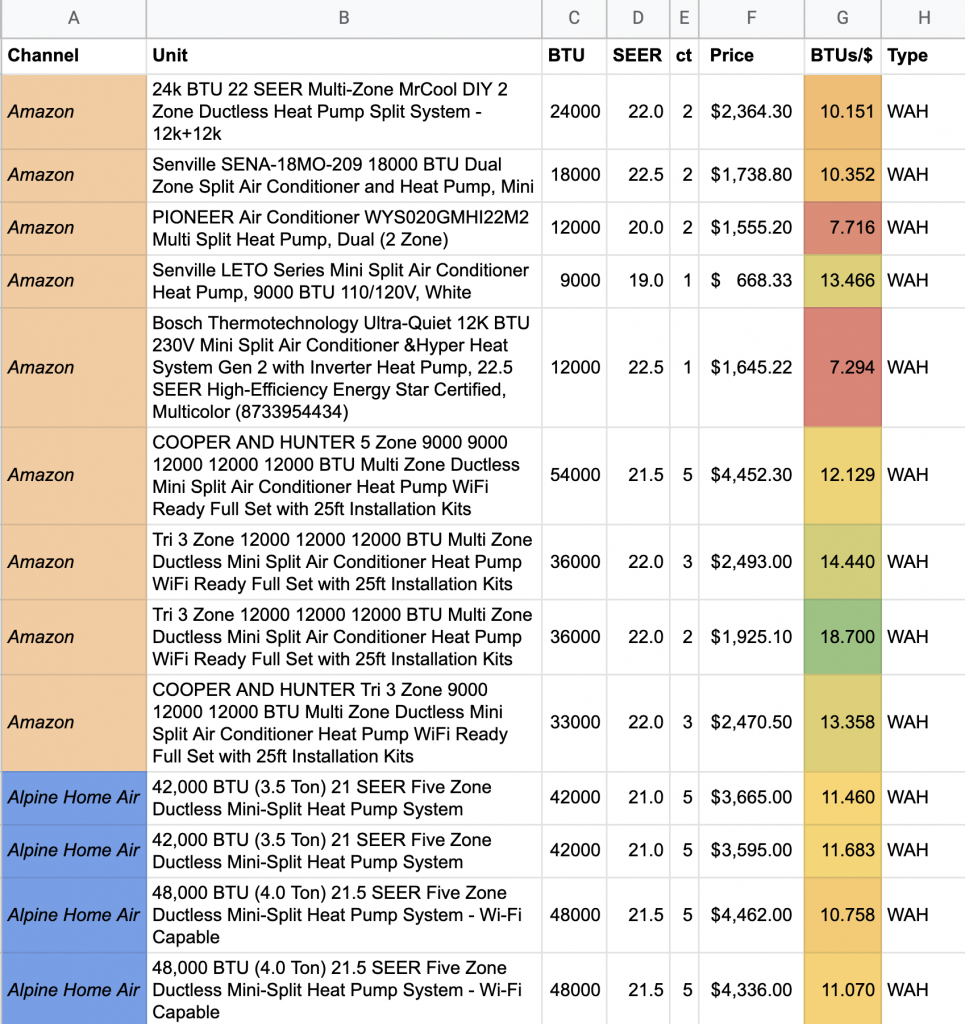
Technical Design Questions
Where will you put the outdoor units? Where will you put the indoor ones? How big is your electrical panel? Do you have to mount them into the walls, or can you mount them on the ground? Consult your local code. DIYer’s please be aware that it’s inadvisable and generally illegal to mess with your own refrigerant. We did 80% of the labor for our system ourselves and then paid $400 for an HVAC tech to hook up and test the lines in about 30 minutes. The electrical was more of a hassle than the HVAC connection and took about 80% of the time, but the HVAC cost about 80% of the total labor costs. Pareto whatever, God bless the trades, etc.
Costing: Methodology & Conclusions
So, which one to buy for you? It’s easy to find this whole thing confusing when there are like 50 options and each one is a thousand-some dollars. Thus I break down each unit by the BTU’s per dollar you’re paying for. I.e. BTU’s divided by price– simple enough, especially in a ceteri paribus consideration of SEER and HSPF and whatever.
The biggest variable that shifts the price is the move from a wall-mounted air handler to a ceiling-mounted cassette. I don’t really have feelings about these except that it’s a question of preference and spatial feasibility. The wall-mounted units are always much cheaper. There are compact air handlers, and then the ceiling cassettes are much larger than they look, meaning it can be tough to install them in 16″-ish o.c. residential ceilings. Then again, our house has a mixture of 18″ o.c., 17″ o.c., 16″ o.c., 15″ o.c., 14″ o.c., 13″ o.c….
Amazon vs. Alpine
- Amazon: Amazon’s numbers varied even within product pages, so this is something you definitely want to look out for. You don’t want to think you’re getting a 22 and then you’re getting a 15. This was also apparent in variances within documentation from the companies themselves. Just remember that today’s 13 and 14 as a bare minimum SEER today are going to be extremely behind the times five years from now.
- Alpine: The prices on Alpine were not too varied. In stats nerdery, I noted a variance of 2.513 BTU’s/$ for Alpine, but a whopping 11.989 BTU’s/$ for Amazon’s listings. This is unsurprising because a lot of Amazon’s stuff is priced algorithmically. Alpine, in contrast, does but one thing and one thing only– and one thing quite well, and that’s sell HVAC equipment. The downside to this is that it’s hard to get a really excellent deal from Alpine. The upside is, of course, they provide far superior service, both presale and post-sale. With Amazon? Good luck.

Winners & Losers
Generally, my experience with Amazon’s customer service, for things other than household objects, snacks, and discount Brazilian footwear, has been so atrocious that I am loath to suggest anyone go there first. If you do, though, the winner is this three-head system from Cooper & Hunter, a Florida-based distributor that sells essentially white-labeled mini-split products from China. They generally get pretty decent reviews. The spec sheets are not terribly clearly presented from C&H, so it’s unclear what some of the efficiencies actually work out to. This is not a problem you’ll have with Alpine, but it’s up to you whether that’s worth the price premium.
- Most Economical Operation: This unit from Alpine is so efficient that it can run on a 10-amp breaker. That’s half of a regular circuit for a residential electrical system. It’s 9,000 BTU’s and, while it only gets you 7.092 BTU’s per dollar (at the lowest end), the efficiency is simply unbeatable. Our extrapolation suggests that this would provide you with savings of around 74% over a base 9 SEER rating. (We’re using window units now, so that might be more like a 5-8 SEER).
- Most Economical Purchase: This three-head system from Amazon has not only a 22 SEER rating, it also gets you a whopping 18.7 BTU’s/$. We calculated this based on the 10% cash back discount that Amazon is offering for God-knows-what-reason. This is kind of unheard of, but it’s unclear how long it will apply, because Amazon tends to play games with discounts like this, which may last for 45 minutes, or may last for years.
- Least Economical Purchase: The big names are going to be the most expensive. What do you get for that price premium? Honestly, probably slightly better service– but probably not much else. Mitsubishi invented the damn thing, so they’re probably going to always carry that premium. Bosch is selling them now, too, although I really doubt they make their own.
- Least Economical Operation: Pioneer had a listing on Amazon for a 15 SEER unit, and that is lousy compared to the low to mid 20’s that are common on both Amazon and Alpine. HSPF and SEER are also comparable in thinking about what to buy vs. what not to buy. Compare the 15.0 HSPF of the 38 SEER unit to the 10 HSPF of the 22 SEER unit.
Planning For Long-Lived Equipment And Escalating Rates
One of our close-conspirators, asked about whether it was worth it to consider the price premium for the 38 SEER– which is more than double that of the lower-SEER units- pointed out that Consumers Energy’s recent implementation of time-of-use premium surcharges for peak periods is going to make the efficiency of systems ever more critical. He said that he is “100% sure” that DTE is not far behind in this regard. Translation: More efficiency means that the price premium is probably worth it because electric rates are going to go up. There’s also a sizing benefit around electricity. This will become critical with increased adoption of electric vehicles. We could cool and heat our whole house with around six of these 38 SEER units. That’s 60 amps on 6 breakers– a lot of breakers, but not much ampacity compared to a regular air conditioner.
Do you have a mini-split? Love it? Hate it? Got a fully electrified crib? Let us know!

